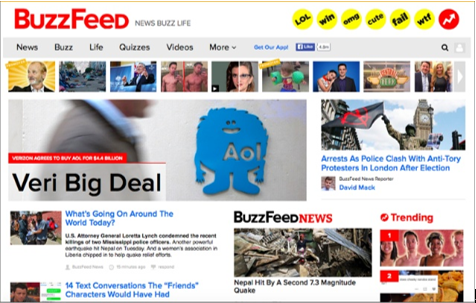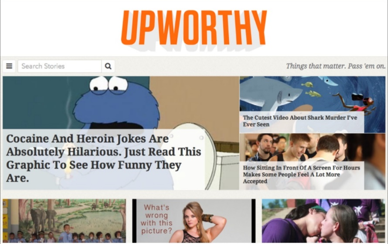the purpose
In the second research, we will research several foreign curation media companies with business models and strategies that have not yet been established in Japan, and examine the possibility of success if they were operated in Japan. In particular, we will focus on new monetization methods, and will also discuss precautions and success points when applying them with optimizers.
Review of last time
The first study started with the background of the rise of curation media in Japan, and analyzed the differences and trends with curation media overseas. The results revealed that the strategies of curation media in Japan and overseas are vertical and horizontal development. Based on monetization methods, he concluded by listing three points about curation media that can be monetized in the future. However, as a reflection on last time's analysis, overseas analysis was a little easier. This time, we will conduct in-depth research on overseas curation media and introduce business models and monetization methods. We will examine the possibility of success if it is operated in Japan, as well as its application with an optimizer.
Main topic
Introduction
In the first study, we found that overseas curation media are horizontal media. It personalizes articles using a unique algorithm and works with social networking sites to encourage their spread. this is"viral media"It is also said that So, specifically, what kind of curation media is popular overseas? What strategy does it use? Next, we will conduct case studies of two currently popular overseas curation media sites.
Case study of overseas curation media
BuzzFeed
*Japanese version site released from January 19, 2016
BuzzFeed, an online curation media founded in 2006, received a $200 million capital increase from Comcast Group's NBCUniversal in August 2015, and is currently a rapidly growing curation media. It was founded by Jonah Peretti and Kenneth Lehrer, who also founded the Huffington Post. While many online media outlets struggle with monetization, BuzzFeed is leveraging its social virality to monetize. The core of this is native advertising, which generated annual revenue of 13 billion yen as of 2014.
Tami Daley, senior director of research at BuzzFeed, says the return on investment (ROI) for native advertising is extremely high. The native ad for Toyota Motor Corolla was posted on this site as a simple combination of short text and video, and reached 1 million page views in two weeks.
[Toyota Motor Corolla native ad]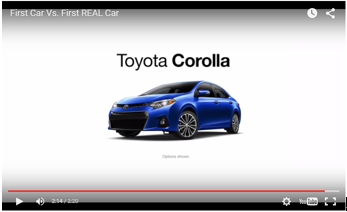
BuzzFeed is like an advertising agency. They accept submissions of native ads on their own, have their production department produce them, and use their specialty, virality, to reach a wide audience. There is no need for media buying, and everything is a one-stop service. At the UK branch, 50 people, or one-third of all employees, work in agency roles.
Tom Standridge of The Economist calls the model "with built-in agency functions" a "new model" and says:
“BuzzFeed and Vice appear to be agencies masquerading as news organizations. It’s a new beast.”
BuzzFeed also generates original content using "reaction buttons" and "quiz/questions." It has an interesting mechanism that encourages users to participate in the content, rather than simply viewing it as a medium for acquiring information or reading material. Like us on Facebook! By showing multiple emotion buttons, it is possible to analyze what types of content are acted upon and what trends tend to be shared in the content. Quiz content has a good response from users and sometimes makes up most of the top 10 shares on Facebook.
[Reaction button and quiz/question (red frame)]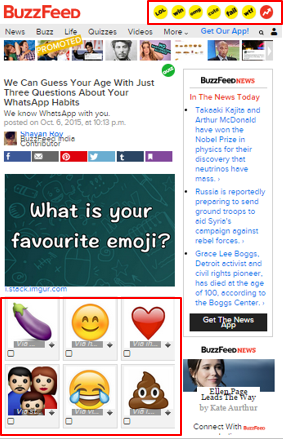
[Top 10 content shared on Facebook]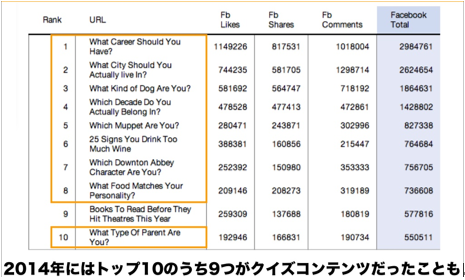
The most important feature is the ability to understand the market share structure using the proprietary analysis tool "Pound." As a result of implementing Pound, BuzzFeed has amassed more Pound data in just one month than the amount of data it has constantly collected for content optimization since its founding. And they came to a conclusion.
Pound developer Dao Nguyen and engineers Andrew and Adam Kelleher focused on the path to sharing and the "connections" between people affected by sharing. (See the figure below) Until then, it was assumed that shared "connections" were structured like a single tree, shared by each individual service (left), but in reality, each service The structures are organically intertwined, resembling a forest (right).In short, the share structure is complex.
[Share structure]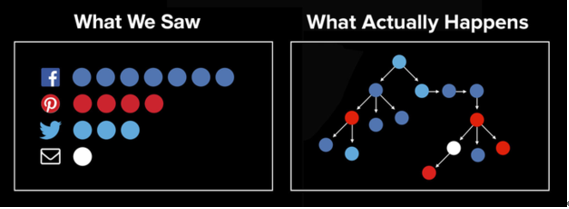
Also, SNS such as Facebook and Twitter have different roles in spreading the word. If you pay attention to "shares", Facebook outnumbers other SNS. An analysis of the BuzzFeed article "What Colors Are This Dress?", which became a hot topic in Japan, revealed that the post on the official BuzzFeed Facebook account received approximately 8.6 million views directly. Brought to you. However, the figure below is a network diagram showing how it spreads, and the spread from Facebook posts is often completed within Facebook and rarely spreads to other services.
[Diffusion network diagram starting from Facebook post]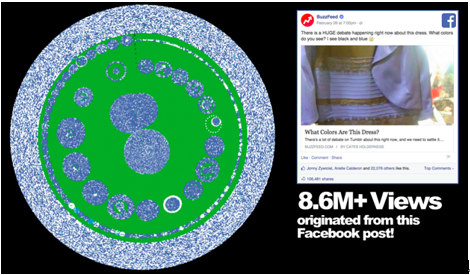
*Dark blue = Facebook, light blue = Twitter, white = blogs, news sites, etc. outside of social networks
Twitter, on the other hand, is different. Approximately 975,000 views came directly from posts on the official Twitter account. However, the above diagram of the diffusion network starting from Twitter posts shows that Twitter has the ability to spread information to other platforms. An additional 987,000 views came from tweets other than the official Twitter account, as well as social networking sites and news sites other than Twitter.
≪Consideration≫
Here are three BuzzFeed strategies derived through research.
① Revenue from native advertising
As mentioned in Part 1, news media is compatible with native advertising. BuzzFeed's revenue shows that growth through the mutually complementary effects of curation media and native advertising is the same overseas as well.
②Creator > Curator
Multiple reaction buttons allow users to pattern out what they think and what actions they take. BuzzFeed, which creates unique content by adding quizzes and other content based on data, can be said to be acquiring users through creation rather than curation.
③ Mechanism analysis of digital sharing
It uses its own technology to analyze user actions. It's very efficient, and instead of optimizing each element displayed on the wall, it optimizes the site daily based on shared past data.
Upworthy
"Upworthy" (a word coined from the words "Up" and "Worthy"), a liberal online news site founded in March 2012, has amassed 3,000 monthly unique users in just 14 months since its launch. It is currently the most shared news site with over 10,000 users.
[Changes in the number of visits after the launch of Upworthy Vertical axis: Number of unique visits per month Horizontal axis: 3 months]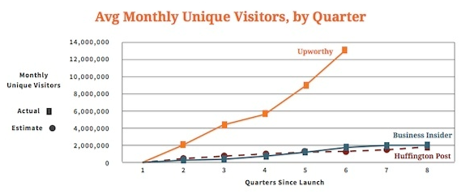
[Changes in the number of visits after the launch of Upworthy Vertical axis: Number of monthly unique visits in the United States Horizontal axis: Year]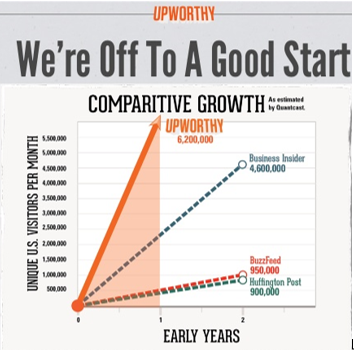
Although it is a news site that is not yet very familiar in Japan, Upworthy boasts a spread and growth speed that surpasses even the Huffington Post and the social media news site Mashable, making it a good example of how curation media should be. It is.
Unlike regular news curation media, Upworthy's mission is to convey information that is extremely liberal and socially meaningful, such as same-sex marriage and global poverty issues. It is also a unique news curation media where curators carefully search for content that already exists on the web (mainly videos and images) and publish articles with attractive titles and lead sentences. It is. As shown in the chart below, Upworthy's average score is at the top with 833 points, far ahead of second place, and BuzzFeed, which I introduced earlier, is in third place.
[Top 25 most shared sites]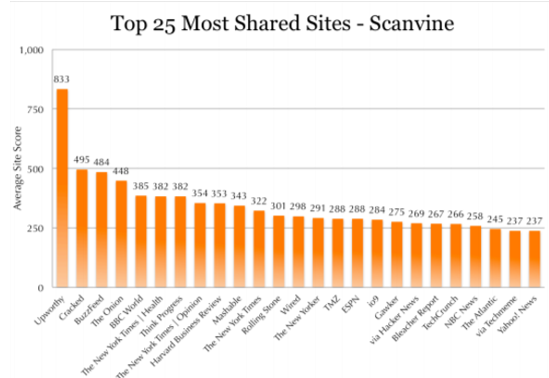
Upworthy is a collaboration between Eli Pariser, former executive director of MoveOn.org, one of America's largest liberal civic and political organizations, and former manager of The Onion, a media outlet specializing in social satire. It was founded by Peter Koechley, the editor of the magazine. In particular, it is supported by an inflow from sharing on SNS, and the degree of sharing is outstanding. According to Similarweb, just under 80% of traffic comes from SNS.
[Inflow route to Upworthy]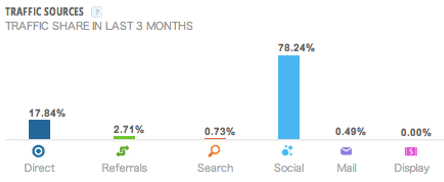
[Breakdown of inflow via SNS]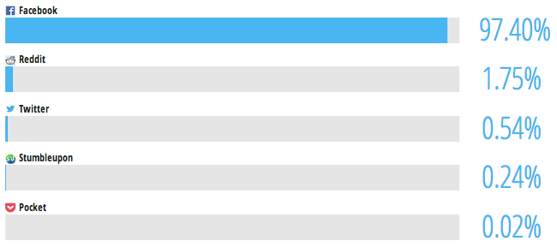
Why are you gaining so many users through SNS? There are two reasons
The first is to have the news selection staff create 25 different titles and put them into an in-house click test system called the "magic unicorn box" to narrow it down to just one. This is because we believe that in order to intuitively get people interested in what lies beyond the link, it is most important to draw attention with an attractive title.
The second is that we have the best ability to determine whether an article will be a hit and our ability to sell it. Creativity is not limited to a limited number of employees, but is entrusted to everyone on the planet. Upworthy is in charge of polishing the diamond in the rough.
The third is to thoroughly pursue ``what we need to do to be shared.'' In order to increase the share rate, we not only write out 25 titles, but also conduct AB tests to increase the number of shares per view by repeatedly testing the design and template. They place particular emphasis on Facebook, and optimize each element displayed on the wall on a daily basis, but unlike BuzzFeed, they optimize shares through a steady trial and error process.
As an example, there is a video introduction. It follows a 17-year-old boy who is diagnosed with cancer and given only a few months to live. This is a moving story of a young man who tries to live positively until the end, even in the face of death, by recording songs he wrote and composed himself. Even though the video itself had already been featured on TV shows and news sites, the excellent title brought 15 million visitors to the site.
The title is ``This Kid Just Died. What He Left Behind Is Wondtacular.'' (Wondtacular stands for Wonderful and Spectacular.) It is a slang word that is a combination of . The original song that the deceased young man had uploaded to the iTunes store reached number one in the rankings.
≪Consideration≫
Here are three Upworthy strategies derived through research.
① Title life
It is very important to create a title sentence that attracts attention for content that is buried under too much information. It's true that no matter how good a product is, if users don't know about it, they won't be interested, and they won't be able to make a purchase. Similarly, for curated content, attractive titles are essential in order to be recognized by users. Upworthy is thoroughly optimizing its awareness by placing emphasis on social media.
② Creator < Curator
Upworthy is just a curator. We are honing our skills in collecting, selecting, editing, and sharing existing content. Anything that gives people emotion and empathy will definitely be shared, and they have an excellent ability to produce it in-house.
③Shareable & clickable
Through repeated trial and error, we have been able to raise the number of users we have today by asking "Why is it being shared?" and "Why is it being clicked?" It's not like he has a high batting average. He has established a method of success simply by doing the math. The quality of the content is often poor.
New business models and monetization methods
decentralized media
Up to this point, I have described the contrasting strategies of viral curation media through the case studies of BuzzFeed and Upworthy, but Buzzfeed has a ``next concept'' that will determine the future of the media business.
According to Buzzfeed Editor-in-Chief Ben Smith...
``The company's idea is ``decentralized BuzzFeed.'' It's a team of about 20 people trying to produce content that relies entirely on other popular platforms like Tumblr, Instagram, and SnapChat. All BuzzFeed content could live on other platforms. For example, Facebook. Even back then, BuzzFeed's main traffic came from there. ”
In other words, Buzzfeed no longer has its own website and is considering a strategy of ``getting rid of its own website'' by distributing content within major SNS platforms.
The reason media outlets until now have had to focus on attracting customers to their own media is that they generate revenue by having users view the advertisements displayed there. This business model has essentially remained unchanged from the dawn of web media to the present day. Distributed content is truly a ``reversal idea'' that will transform this traditional web media business model.
In fact, traffic from referrals (dark circle in the center) is a very small number compared to content viewers. Buzzfeed has 847 million impressions on Twitter, 6 billion on Pinterest, and 11.3 billion on Facebook. The number of users who view Buzzfeed content distributed on SNS such as Facebook and Twitter is overwhelmingly greater than the number of users who actually visit the Buzzfeed site linked from there, so the number of users who view Buzzfeed content flowing on SNS such as Facebook and Twitter is overwhelmingly higher than the number of users who visit the Buzzfeed site that is linked from there. If you look at the diagram below, you can understand that we will distribute content that is optimized for each external platform without posting any links.
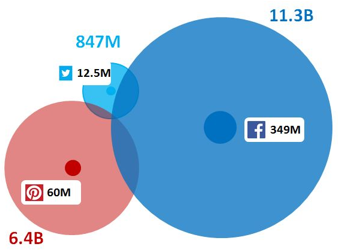
This idea comes about because the source of revenue is native advertising. With native advertising, the key is how many people can see it, and the PV of the entire site is the indicator. In that case, instead of linking to your own articles on Facebook, it would be better to distribute the content as it is so that more users can see it. This is the theory. Although Buzzfeed's stance is to "go to places where customers gather, rather than inviting them to my place," Buzzfeed's decentralized content (departing from its own site) is just a concept and has not yet been implemented.
Advantages/disadvantages of distributed media
Advantage: No matter how many hundreds of millions of page views you get a month, operating costs are low because it's not your own site. If there are no server fees, there is no need for engineers to support the infrastructure.
Disadvantage: Everything is under the rules of other companies' platforms. For example, if Facebook were to make major changes to specifications or algorithms, they would have no choice but to comply. You cannot do business without permission within each platform. In addition, as it becomes impossible to expect an unlimited number of inflows through SEO, it may become a battle of attrition as each content has to compete. It is not suitable for cases where the original main source of traffic was SEO, or for content that is unlikely to spread on SNS.
Case study: NowThis
However, there are already startups implementing Buzzfeed's vision. That is "Nowthis".
NowThis is a media that mainly distributes short video news of less than one minute. It was launched in 2012 by Huffington Post co-founder Kenneth Lehrer and former Huffington Post CEO Eric Hippeau.
As shown in the image below, Nowthis's own website only has one TOP page, and the rest only includes directions to each social platform. The message that ``the term ``homepage'' is outdated is now outdated. The news exists ``there,'' where you are.'' is an impressive message.
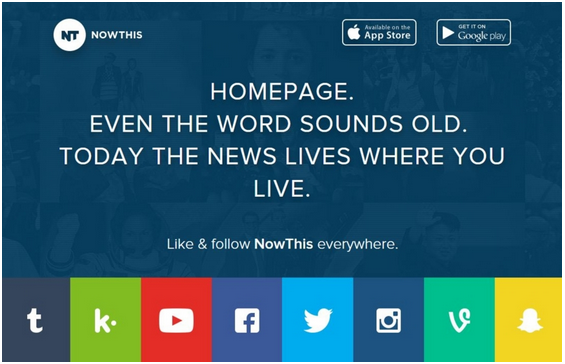
Because each platform has user preferences and service limitations, videos are re-edited and optimized before being distributed, such as 6 seconds on Vine and 15 seconds on Instagram. By the way, the response has been 770,000 fans on Facebook, 360,000 followers on Twitter, 140,000 followers on Youtube, and 5 million views per month on Instagram.
So how does Nowthis make money? The diagram below shows the business model and monetization.
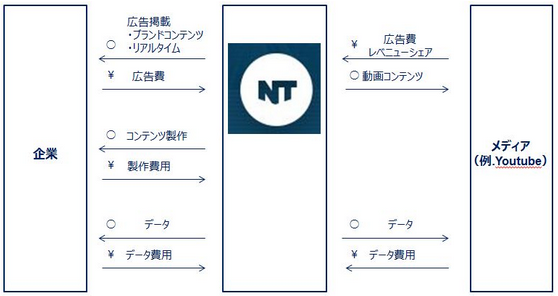
It generates revenue by creating video content requested by client companies and by crediting the names of advertisers with high affinity with regular video content in headlines. However, this is no different from a commercial production company.
Also, revenue share is not uncommon in the media world. In Japan, this means distributing content to Yahoo News and receiving revenue back according to the PV on Yahoo News. The fact that Nowthis's branded content format is video is accelerating the move away from creating an in-house website. What do you mean? In order to generate value without attracting brand advertisements to your site, the content distributed to other companies' platforms must have content value on its own. This is because while the amount of information that can be conveyed with conventional image + text content is limited, video makes it possible. Currently, about 60% of internet traffic is video, and we are in the ``video age,'' which is said to reach 80% by 2018 or 2019. NowThis can be said to be ahead of the curve.
The new monetization method is the "data sales model." Although they are still in the process of exploring what kind of content is popular, they hope to create and provide monetary value to information by leveraging their strengths in constantly researching what kind of content is popular and possessing data on each platform. We sell how to publish content on all platforms, such as, ``This kind of video will lead to this kind of action on this platform.'' This revenue model may hold promise in the future.
conclusion
Chances of success in Japan
Before we get to the conclusion, let me briefly summarize the market situation for curation media (news) around the world.
[How news curation media flows in by country]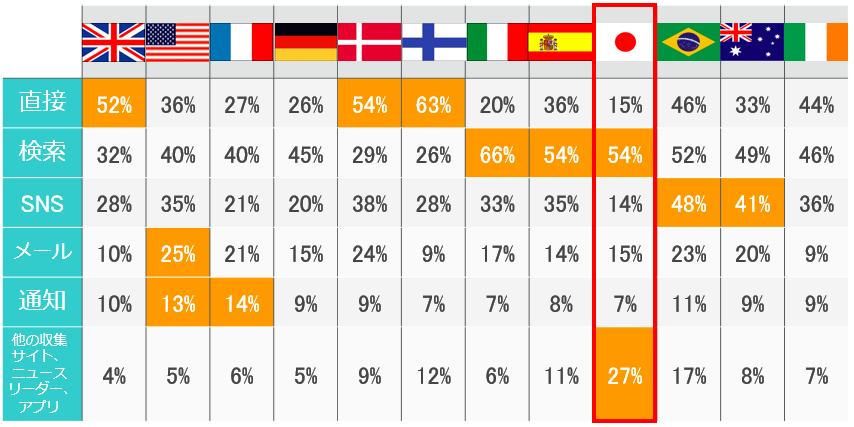
How do people flow into the target media? In the US, search is 40%, direct is 36%, SNS is 35%, email is 25%, and notification is 13% (results with multiple answers). The surprising result was that in the United States in particular, the number of "notifications" has doubled in the past year (from 6% to 13%, although the number is small).
Regarding the payment status for online news, 11% in the US, 6% in the UK, and 10% in Japan pay for online news. Considering the current situation in each country, the average monthly charge for online news is $10.
Furthermore, regarding the type of billing (continuous or one-time), the data shows that recurring charges such as monthly charges are 60 to 701 TP3T, and one-time charges are 30 to 401 TP3T. Countries such as France, Spain, and Italy are all hovering around 50%. For example, Blendle in the Netherlands is a popular platform that charges for each article, so there are possibilities other than paywalls.
By the way, as of last year, it is said that more than 500 American news sites had implemented paywalls (Nieman Lab). However, the number of people who do not pay at any price is 67% in the United States, accounting for 60-70% of all countries, so it is currently difficult to overcome the resistance to charging.
I would also like to talk about paper newspapers. For paper, Japan is at the top with 61%, and America is at 35%. Looking around the world, many emerging media outlets, including BuzzFeed, Upworthy, and Newthis, are focusing on video, and people are spending less time watching TV and newspapers. Meanwhile, Japan's ``paper'' still has strong roots.
If you look at the data for Japan (red frame) in the chart above, you can see that Japan is a slightly different market from other countries around the world. The characteristics of Japan are...
①Many traffic from search
②The proportion of traffic from SNS is the lowest in the world
③The highest percentage of traffic from curation apps in the world
It is. Considering whether this market situation matches Nowthis's strategy...
As for ②, there are two possible patterns: ``I don't consume news on SNS in the first place'' and ``I only consume news on SNS and do not flow to my own site'' as in the case of BuzzFeed. If the situation is the latter and not the former, Nowthis's strategy is effective. However, ① and ③ are problematic.
In contrast to ①, which is a decentralized media where SEO is a waste, there is a strong preference for consuming news through search. In that case, it may be more effective to have your own website.
③ is evidence that curation media such as Yahoo News, SmartNews, Gunosy, and LINE News are supported, but it does not fit into Nowthis's strategy. why? This is because apps are completely the opposite of the idea of decentralized media. Nowthis' stance of going out of their way to go to the customer's location is to have them install an app and have them access an app that they can only see there. This may not be well received in the Japanese market.
The conclusion to be drawn based on these characteristics of the Japanese market is that it is currently difficult for a business model like Nowthis to succeed in Japan. However, it is necessary to verify the actual situation in ②. This is because you can expect success depending on the results. Above all, decentralized media does not exist in Japan, so there is no recognition of it at all. There may be a possibility that it will be accepted in Japan if it is recognized. In addition, regarding monetization, the ``data sales model'' utilizes marketing data to make strategic proposals regarding trends in each content and how to sell it, which is what can be called ``consulting income.'' Being able to provide this will be an added value to our customers in an era where SNS will become more and more infrastructure, and the shift to smartphones and videos will become commonplace.
Application in optimizer
A major advantage of distributed media is that operating costs are lower than ever. Above all, we can be a pioneer in that no one else in Japan offers it yet. However, there are many disadvantages as well. The main premise is that it's a video ad, and if you're going to organize a department for each SNS/category, you'll need a certain number of people.
Furthermore, around the world, news curation media will continue to be consumed on smartphones. (See the diagram below) Of course, advertising costs will also shift from TV to smartphones.
[Trends in news consumption on smartphones 2012-2015]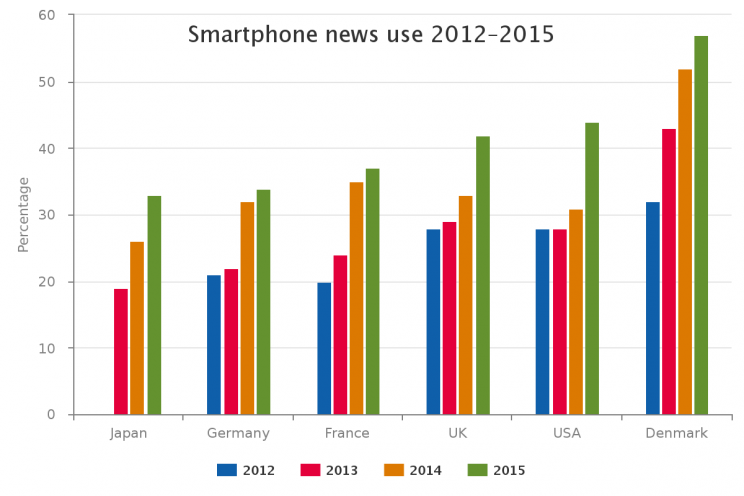
Additionally, Facebook is the most frequently used social networking site for the purpose of obtaining news curation. If you add 41% for people who use it to get news, and 9% for WhatsApp, it becomes 50%. YouTube's 18% and Twitter's 11% are far apart. (See figure below)
[Sort of SNS used when consuming news]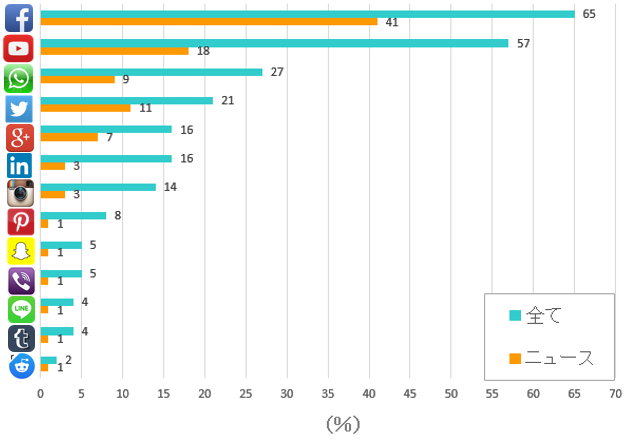
Regarding motivation for watching the news, ``I want to know what's going on in the world (84%)'' was the top answer, while surprisingly ``Killing time (31%)'' was the lowest answer. In this way, it can be seen that the global trend is ``news consumption on smartphones on SNS''.
The ``data sales model'' in monetization can be applied with an optimizer. For SNS, we offer share optimization, and for advertisers, we offer SNS promotion, and our mutual proposal position is similar to the marketing strategy we have cultivated at the current AF Network. Distributed media enables strategic proposals for Internet infrastructure.
Initiatives for next time
This time, I learned about the existence of Nowthis and was able to learn about the existence of a new monetization model, although it is still being explored. However, we have not fully determined whether it will truly be successful in Japan. Next time, we will analyze several Japanese curation media sites on the ``method of inflow'' and ``structure of share'' necessary for the establishment of decentralized media.
source
Book: Curated by Steven Rosenbaum Translated by Makito Noda Publisher: President Publishing (December 2011)
DIGIDAY: Only 1/3 of people use news apps even once a week. Reuters survey shows current state of news consumption.”
netratings "Top 3 news curation apps have more than doubled the number of users since the beginning of the year"
DIGIDAY "The management strategy that led to BuzzFeed's success. All of the history of the many rich people coming together.”
GinzaMetrics “Learning from the viral media “Upworthy” 5 important things to make it go viral”
ZOWEB “A media ahead of Buzzfeed? What is Nowthis’ decentralized content strategy without a website and its business model? ”
![]()
Back issues of this series
Part 1: Analysis of curation sites and research on their growth potential
Part 3: Possibility of success in decentralized media in Japan <NEW>
Related pages
Comprehensive web strategy consulting
[calltoaction01]
